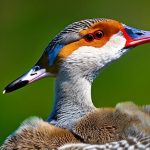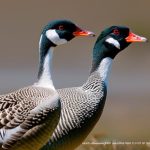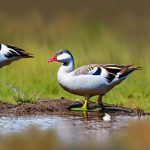Exhibition geese have a long and storied history, dating back to ancient times when they were prized for their meat, eggs, and feathers. The domestication of geese can be traced back to ancient Egypt, where they were raised for food and as guard animals. Over time, geese became popular in Europe and were often kept by nobility for their ornamental value. In the 19th century, geese began to be exhibited at agricultural shows and fairs, where they were judged based on their size, shape, and plumage. This marked the beginning of the exhibition goose as we know it today.
In the early 20th century, exhibition geese became increasingly popular in the United States, with breeders working to develop new and improved breeds for show purposes. Today, exhibition geese are a common sight at agricultural shows and fairs around the world, where they continue to be judged based on their physical attributes and overall appearance. The history of exhibition geese is a testament to the enduring appeal of these beautiful and versatile birds.
The Different Breeds of Exhibition Geese
There are several different breeds of exhibition geese, each with its own unique characteristics and features. Some of the most popular breeds include the Toulouse, Embden, and Chinese geese. The Toulouse goose is known for its large size and distinctive gray plumage, while the Embden goose is prized for its pure white feathers and elegant appearance. Chinese geese, on the other hand, are easily recognizable by their knobbed heads and graceful necks.
In addition to these well-known breeds, there are also lesser-known varieties such as the Sebastopol, African, and Pilgrim geese. Each breed has its own specific traits and qualities that make it well-suited for exhibition purposes. Whether it’s the striking appearance of the Sebastopol goose’s curly feathers or the unique sex-linked coloration of the Pilgrim goose, there is a breed of exhibition goose to suit every taste and preference.
Unique Characteristics and Features of Exhibition Geese
Exhibition geese are known for their striking appearance and distinctive features. One of the most notable characteristics of exhibition geese is their plumage, which can come in a wide range of colors and patterns. From the pure white feathers of the Embden goose to the striking gray plumage of the Toulouse goose, exhibition geese are a feast for the eyes. In addition to their beautiful feathers, exhibition geese also have elegant necks and graceful postures that make them a joy to behold.
Another unique feature of exhibition geese is their vocalizations. Geese are known for their loud honking calls, which can be heard from great distances. This makes them excellent guard animals and adds to their overall appeal as exhibition birds. Additionally, exhibition geese are known for their friendly and sociable nature, making them a popular choice for hobbyists and breeders alike.
The Importance of Exhibition Geese in Agricultural Shows and Fairs
Exhibition geese play a crucial role in agricultural shows and fairs, where they are showcased and judged based on their physical attributes and overall appearance. These events provide breeders with an opportunity to showcase their best birds and compete for prestigious awards and recognition. In addition to being a source of pride for breeders, exhibition geese also serve as ambassadors for their respective breeds, helping to promote awareness and appreciation for these beautiful birds.
Furthermore, agricultural shows and fairs provide an important platform for education and outreach about geese and poultry in general. Visitors to these events have the opportunity to learn about different breeds of geese, their care requirements, and their role in agriculture. This helps to foster a greater understanding and appreciation for these birds and the important role they play in our lives.
Caring for Exhibition Geese: Tips and Guidelines
Caring for exhibition geese requires careful attention to their specific needs and requirements. Proper housing is essential to ensure the health and well-being of exhibition geese. They should be provided with a secure and spacious enclosure that protects them from predators and inclement weather. Additionally, exhibition geese require access to clean water for drinking and bathing, as well as a balanced diet that includes a mix of grains, greens, and protein sources.
Regular grooming is also important for exhibition geese, as it helps to maintain their beautiful plumage and overall appearance. This includes regular bathing to keep their feathers clean and free from dirt and debris. Additionally, exhibition geese should be provided with ample space to exercise and stretch their wings, as this helps to keep them healthy and happy.
Breeding and Rearing Exhibition Geese
Breeding and rearing exhibition geese requires careful planning and attention to detail. Breeders should select high-quality breeding stock with desirable traits such as size, shape, and plumage. It’s important to carefully pair compatible birds to ensure healthy offspring with the desired characteristics. Additionally, proper nutrition and healthcare are essential for breeding geese to ensure successful reproduction and healthy chicks.
Rearing exhibition geese also requires careful attention to their specific needs at different stages of development. Chicks should be provided with a warm and secure brooder environment with access to clean water and a balanced diet. As they grow, young geese should be gradually introduced to outdoor environments where they can learn to forage and socialize with other birds. Proper socialization is important for exhibition geese to ensure they are well-adjusted and friendly towards humans.
The Future of Exhibition Geese: Trends and Developments
The future of exhibition geese looks bright, with continued interest in these beautiful birds from hobbyists, breeders, and enthusiasts around the world. There is a growing trend towards sustainable and ethical practices in poultry breeding, which bodes well for the future of exhibition geese. Additionally, advancements in genetics and breeding techniques are leading to the development of new and improved breeds with desirable traits for show purposes.
Furthermore, there is a growing interest in heritage breeds of exhibition geese, which are valued for their historical significance and unique characteristics. This trend towards preserving rare and endangered breeds helps to ensure the continued diversity and vitality of exhibition geese for future generations to enjoy. With ongoing education and outreach efforts, it’s likely that exhibition geese will continue to be a beloved feature at agricultural shows and fairs for many years to come.
Meet Walter, the feathered-friend fanatic of Florida! Nestled in the sunshine state, Walter struts through life with his feathered companions, clucking his way to happiness. With a coop that’s fancier than a five-star hotel, he’s the Don Juan of the chicken world. When he’s not teaching his hens to do the cha-cha, you’ll find him in a heated debate with his prized rooster, Sir Clucks-a-Lot. Walter’s poultry passion is no yolk; he’s the sunny-side-up guy you never knew you needed in your flock of friends!







